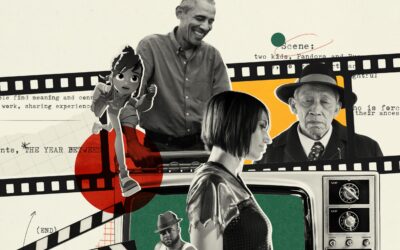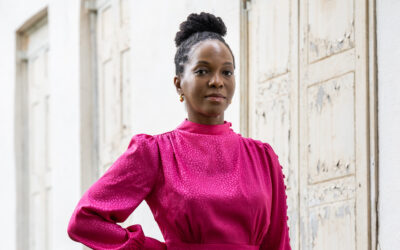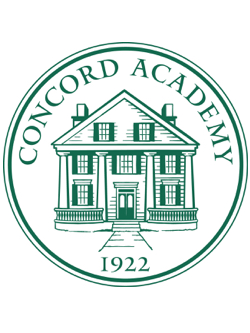
MISSION STATEMENT
We are a community animated by love of learning,
diverse and striving for equity,
with common trust as our foundation.
Honoring each individual, we challenge and expand
our understanding of ourselves and the world
through purposeful collaboration and creative engagement.
We cultivate empathy, integrity, and responsibility
to build a more just and sustainable future.
Reaffirming Concord Academy’s core values, a renewed mission statement calls on everyone to engage
MISSION REVIEW
TASK FORCE
Co-Chairs:
Marie Myers P’19 ’21, director of enrollment management (15 years)
Laura Twichell ’01, interim academic dean, English faculty, former assistant dean for community and equity (eight years)
Members:
Maggy Godfroy, director of human resources, multiple committees (four years)
Deborah Gray, scheduler, mathematics faculty, recycling assistant coordinator (32 years)
John Grossman P’17 ’19, trustee, chair of the Board of Trustees’ Community and Equity Committee (second term)
Max Hall, science faculty, DEMONs advisor (16 years)
Alyse Ruiz-Selsky ’05, director of studies, college counselor, English faculty, house faculty, former director of student life (one year)
Sabrina Sadique, English faculty, house faculty, Youth in Philanthropy and Muslim Students Organization advisor (three years)
Carmen Welton, Spanish faculty, house faculty, cross-country coach, Alianza Latina advisor (four years)
Last spring, we became co-chairs of a nine-person Mission Review Task Force — faculty, staff, parents, alumnae/i, and trustees — that was given the charge to review and, if needed, revise the statement to ensure that it describes the school CA is and the school it wants to be.
We were asked not to change CA’s values but rather to reflect how we are living our values today. We quickly agreed that love of learning, valuing all individuals in our community, and common trust must remain at the statement’s heart, and that our commitment to lead in the areas of sustainability, social justice, and global citizenship supported and amplified these core values. We also agreed that we wanted the revision to be more active and concise to call every community member to engage fully with the mission.
Over the spring 2019 semester, we met to brainstorm, parse, and debate how best to revise a poetic and beloved mission statement. We are pleased to say that no stone went unturned, no question unasked, no phrase unpolished — and that this was some of the most enjoyable, engaging, and thoughtful committee work we have ever experienced.
We invite you today to delve into Concord Academy’s renewed mission statement, the thinking that went into it, and the ways it is already lived on campus and by alumnae/i around the world. The “we” pronoun in the mission invites every member of our community into the work of upholding the principles we hold so dear, and into the engagement in lifelong learning that this entails. We hope the mission statement speaks to you as much as it does to us.
– Marie Myers P’19 ’21
– Laura Twichell ’01
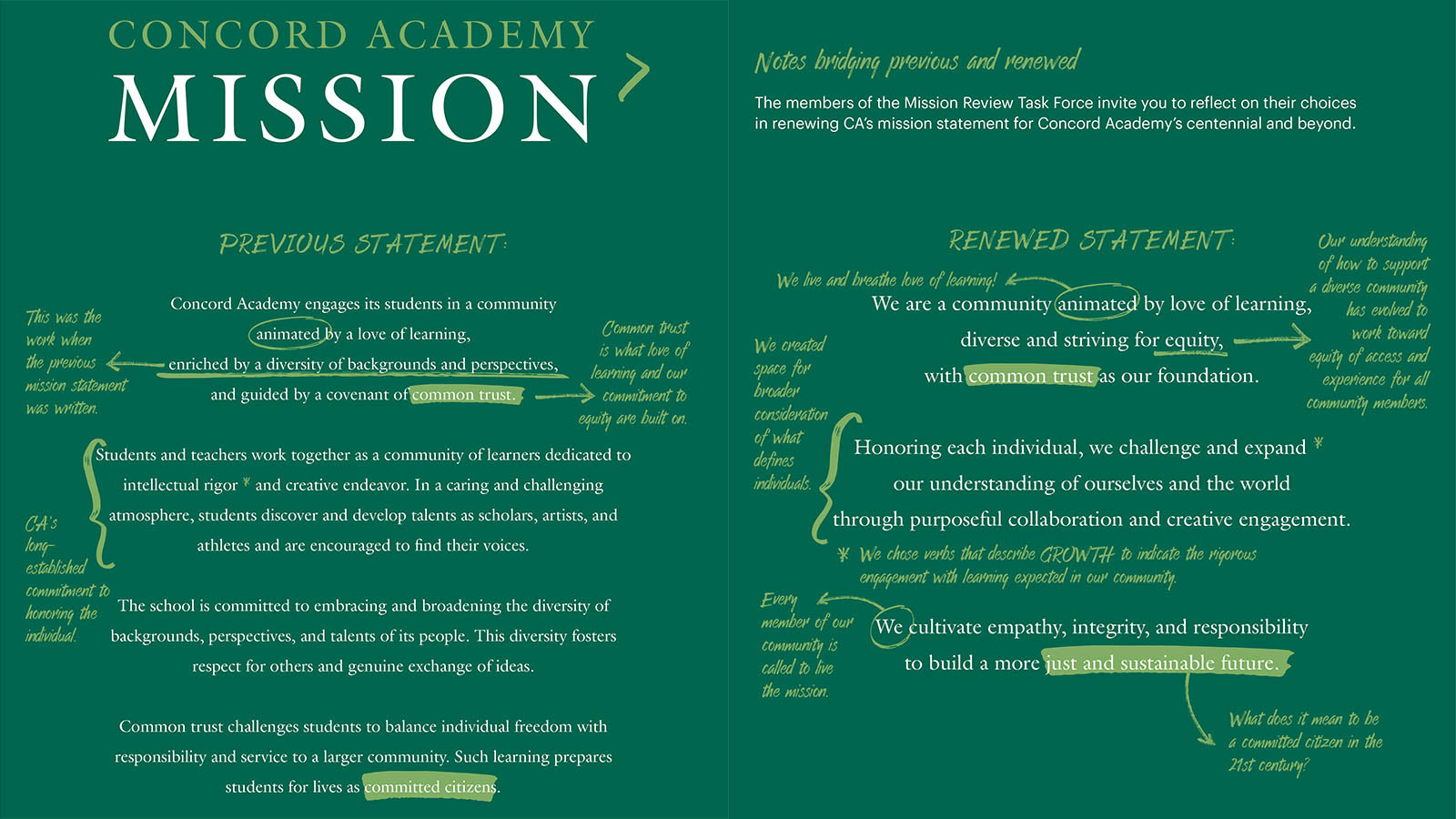
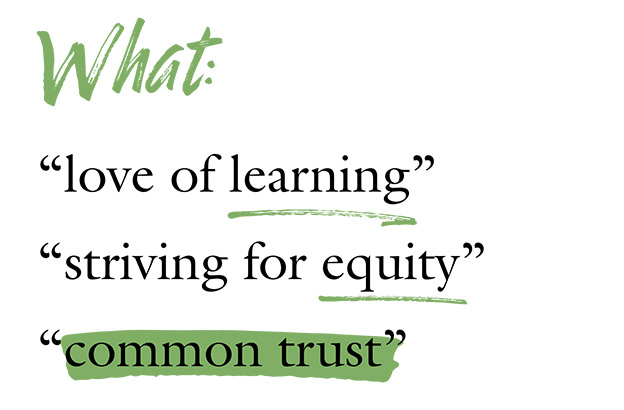
Last fall, a group called Student Action for Social Justice formed at CA to draw attention to inequities in students’ experiences. Tired of having to educate peers about race, class, and gender, these young people shared their struggles with faculty and administrators, and their hopes that everyone, not just those most affected by injustice, would engage around these issues. In his Commencement speech, Head of School Rick Hardy called their approach to seeking dialogue “powerful and positive.”
CA has long been committed to promoting diversity and supporting inclusion. Nevertheless, these students demonstrated that more than the structures already in place — Community and Equity programming, affinity groups, Inclusion Council, Health and Wellness seminars, and school-wide assemblies and workshops — is needed. The pursuit of equity, they showed, is inextricable from CA’s core values of love of learning and common trust.
Around the same time, CA convened the Mission Review Task Force, having already identified priorities — sustainability, social justice, and global citizenship — for the school’s centennial in 2022, and recognized gaps between the school’s stated mission and its work around diversity and equity. During the New England Association of Schools and Colleges reaccreditation process CA completed last year, a visiting committee affirmed that the school should examine whether its mission statement reflected its values as they are lived today. The renewed statement, developed and refined throughout the spring and accepted by the Board of Trustees in May, now explicitly calls everyone whose lives CA has touched to engage in building a more just and sustainable world.
Today, educators at CA are participating in the second year of a Witnessing Whiteness curriculum. Teachers meet, formally and informally, to talk about equitable classroom practices and interpersonal engagement. Their approaches vary, but they share a commitment to learning from and with this community. Recently, faculty read and discussed Joe Feldman’s book Grading for Equity: What It Is, Why It Matters, and How It Can Transform Schools and Classrooms.
Before coming to CA, English teacher Andrew Stevens taught at the Alabama Prison Arts and Education Project, directed literacy programs at the Sunflower County Freedom Project (SCFP) in Sunflower, Miss., and taught in Greenwood, Miss., with Teach for America. In June, he and history teacher Stephanie Manzella P’14 ’17 ’18 brought a group of rising CA sophomores to the American South to deepen their leadership skills and knowledge of American history, culture, and activism. The group traveled to the National Civil Rights Museum in Memphis, Tenn., the Emmett Till Interpretive Center in Sumner, Miss., and historical blues sites and the University of Mississippi in Oxford, Miss., where they spoke with a former student of Stevens’ who is advocating there for the removal of Confederate monuments. Seeking to understand the relationship between segregation and economic suppression, they also learned how activists in the Delta are promoting racial reconciliation.
“Activism and reconciliation are difficult and require a lot of tenacity,” Stevens says. “There aren’t easy answers.” He challenges his students to see racial injustice not as a Southern problem but as a condition that shapes life in the United States.

CA English teacher Nick Hiebert, current holder of the Katherine Carton Hammer ’68 Endowed Faculty Chair, is examining how his white racial identity functions in the classroom and studying inclusive teaching practices.

CA students at the Civil Rights Memorial erected at the University of Mississippi in 2006, which honors James Meredith, who became the university’s first African American student in 1962, and those who fought to give all citizens equal educational opportunities in the South.
Stevens’ English Department colleague Nick Hiebert currently holds the Katherine Carton Hammer ’68 Endowed Faculty Chair and has used funding from that award to study the most effective ways to teach more inclusively and to examine the way his white racial identity works in the classroom. He has traveled to the National Memorial for Peace and Justice and the Southern Poverty Law Center in Montgomery, Ala., and to conferences such as the People’s Institute for Survival and Beyond and the Equity Exchange for public and private school educators. He collaborates with the Community and Equity Office’s Courtney Fields-Thomas and is working with a colleague in English, Abby Laber P’16, who teaches along with him at the Bard Institute for Writing and Thinking, to reconceive how students approach academic essays. “We’re trying to be explicit in talking about assumptions, expectations, and the practice of writing,” Hiebert says.
The Hammer Chair support extends over three years, which Hiebert says has been “tremendously helpful.” “I’ve been able to apply my thinking to my classes more actively and intentionally,” he says. “It’s also reminded me that teaching is what I love. It’s never uninteresting to me.”
History teacher Emma Storbeck, who joined the faculty last year, is consciously taking the time to build community and openly addresses inequality and moments when trust is breached. While teaching about the colonial history of Brazil or U.S. interventions in modern Latin America, for example, Storbeck models backtracking. “I’ll say something, and when I realize I need to, I’ll go back and say it differently,” she says. “I’m consciously modeling apologies and how to make something right, in a kind way — right then, in the moment.”
“Justice and equity work are lifelong commitments, not just on campus but in the world,” Storbeck says. “I appreciate everything the school is doing to emphasize that with adults and students. It’s great to be part of a community that recognizes this, and to teach in a place where my colleagues and students are so passionate about this work.”
CA’s Commitment to Experiential Equity
26.5%
of the student body receives financial assistance
$51,780
the average award for incoming students
106
students are receiving
$5.1
million in aid
CA’s renewed mission statement charges students and teachers alike to “challenge and expand” their understanding of both themselves and the world. “At CA, students grow and change through the insights of all those with whom they share the experience,” Hardy says. “We have committed to this practice because we have seen the depth of learning it creates and how it prepares students to thrive in the complex world they will make their own.”

Laurence Vanleynseele P’22 has been working with her fellow English teacher Andrew Stevens to bring to life The Odyssey, a central text of the ninth-grade curriculum. Wanting to promote slow reading and material intelligence, an awareness of age-old processes and skills, she began focusing last year on weaving as a metaphor for storytelling. Vanleynseele sent science teacher Max Hall, who advises the CA club Dreamers, Engineers, Mechanics, and Overt Nerds (DEMONs), an image of an ancient Greek amphora depicting Odysseus’ wife Penelope at her loom. Could DEMONs build something like this? she asked. “It is nuts,” he replied, “in precisely the way we would like to encourage.”
Under the direction of Annie Lubin ’19, three freshmen — Eliza Morton ’22, Amanda Rosenbaum ’22, and Grace King ’22 — created a warp-weighted loom, fashioning the weights in the ceramics studio, so that all first-year students could try their hands at weaving this year. “It’s important for students to get a feel for this object that is so central to the text, for the activity, the time involved, and the repetitive nature of the work,” Vanleynseele says. “This is an opportunity for us to reflect on the way a plot is constructed and how verbal and conceptual patterns emerge.”
Hall says the loom is “one of the finest examples of a DEMONs project driven by community need” — the club’s stated purpose. Using the school’s 3D printing and scanning tools, and its plasma and laser cutters (the workshop is growing and modernizing each year), DEMONs also recently built specialized storage for the film program, among many other projects. A new engineering course using computer-aided design and computer-aided manufacturing tools debuted last year, and a robotics club is coalescing on campus. “New students are coming with more baseline knowledge of maker spaces than ever before,” Hall says. “There aren’t enough hours in the day for everything they want to take on.”
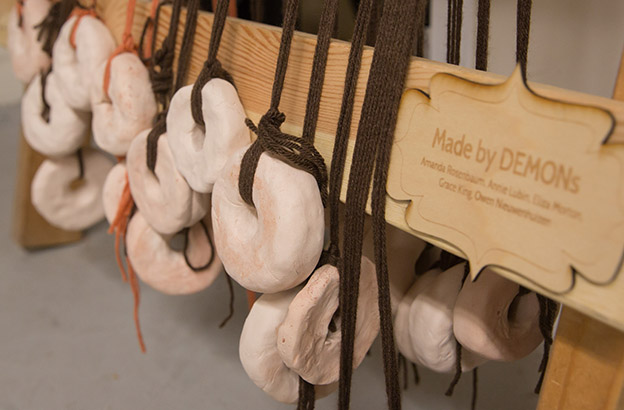
The warp-weighted loom created by students in the DEMONs engineering club to give all CA ninth-graders a hands-on experience of The Odyssey.
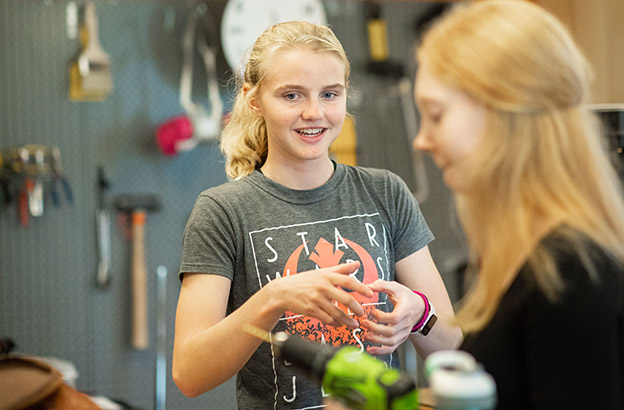
Students working in CA’s fabrication lab.
As the head of CA’s fabrication lab, ever ready to open it to students and colleagues, Hall also contributed to Topics in Engineering: Architectural Design Concepts, Processes, and Technologies in spring 2019. Art teacher Chris Rowe recently reimagined this course to include online learning as well as several hands-on projects. Students explored movement in the dance studio with now-retired co-director of CA’s dance program Richard Colton P’13, who helped them better understand the relationship of the human body to space. A series of exercises evolved into a sculpture project, then a final assignment: to design a chair at human scale that expressed a specific motion, using only cardboard, dowels, and rubber bands.
“Movement was really out of the comfort zone for many of them,” Rowe says, “but surprising students is critical. There’s a danger, especially in architecture, of preconceptions getting in your way.”
After investigating and redesigning social spaces on campus, the architecture students looked beyond Concord. David Nagahiro P’17 ’20 and his colleagues at CBT Architects in Boston mentored the class in urban design, employing as a case study the firm’s award-winning mixed-use residential space in the city, 10 Farnsworth. Student teams developed proposals for turning an empty parking lot into, variously, a Seaport museum, an artist space, a community center, and an innovation hub. And they received feedback from several professional architects, among them Zeke Brown ’87, P’22, of Brown Fenollosa Architects, Inc. in Arlington, Mass.
The Performing Arts Department’s Jessica Cloutier-Plasse, who advised the architecture students last year and will co-teach the class with Rowe this spring, says problem solving is the basis of the class. “Students grapple with experimenting when there are very clear expectations for how to work, but not for what they should be producing,” she says.
Rowe says, “This is the tip of the iceberg of what we could be and, more and more, will be doing as departmental silos are knocked down and people rethink education for the 21st century.”
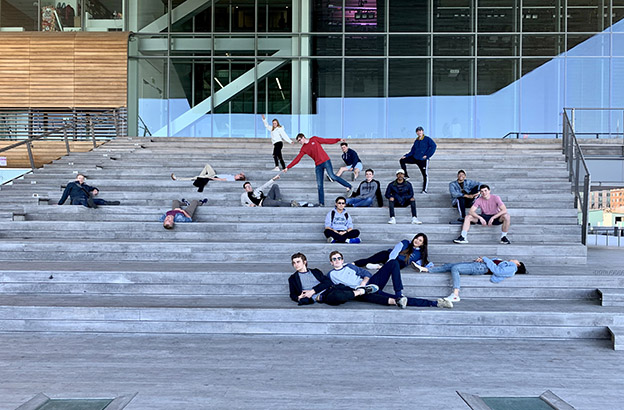
CA students with architecture teacher Chris Rowe on the steps of the Institute of Contemporary Art, Boston.
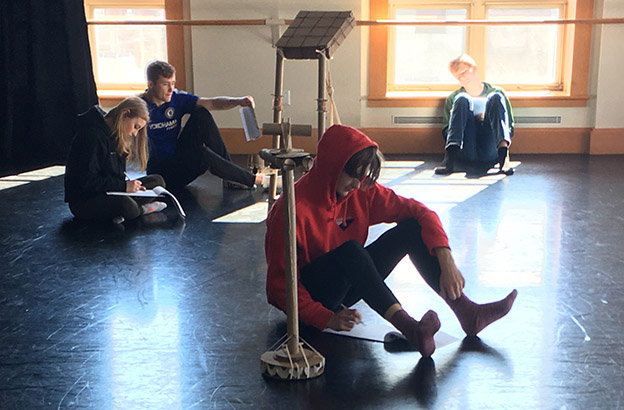
Students reflecting on a chair design project they completed in the engineering of architecture course.
While many such collaborations arise naturally, CA also provides its educators — through the Faculty Leadership Endowed Fund, an initiative of the Concord Academy Centennial Campaign — with resources to develop new curricula, exchange ideas across disciplines, and create and seize opportunities for experiential learning. Beginning in the 2016–17 school year, an endowed faculty initiative called Department X offered funding and release time to help teachers engage students more creatively. The first result was an interdisciplinary course on Concord’s black history, co-taught by history teacher Kim Frederick and film teacher Justin Bull, for which students created multimedia, interactive museum experiences for the nearby Robbins House. The students’ projects, Frederick says, showed “great potential for historical storytelling through drama and media.”
Most recently, CA English teacher Kirsten Hoyte P’22 has been using Department X support to redesign her Digital Stories: Oral Traditions and Interactive Fiction course for next fall. Intrigued by technology’s potential to enrich fictional narratives, during a summer sabbatical in 2017 she familiarized herself with the software Isadora, often employed in dance and theater, which utilizes motion-detector cameras to allow users to interact with images, sounds, and text. This summer, she attended a four-day Isadora workshop in Berlin and returned brimming with possibilities, including for location technologies that could unfold a story in the physical world.
The last time she taught the class, her students’ video experiments enabled them to “know their texts in a more visceral and emotional way than our usual read-analyze-write method,” Hoyte says. “Being willing to move in front of their classmates required allowing themselves to be more vulnerable and open than we usually are in more traditional ‘intellectual’ spaces, and I saw in some students a freedom and confidence that I had not previously seen in the classroom.” For her, the more ways students can experience stories and storytelling, the better.
At CA, the value accorded to storytelling, in classes such as these and in the tradition of chapel talks, places equal emphasis on the storyteller and the listener. This dynamic is part of what defines Concord Academy as a school dedicated to learning and growth, for individuals and in community. The renewed mission statement both reflects this reality and charts a course for CA, one that will be guided by this community’s most deeply held ideals.
FOR THE LOVE OF LEARNING: SENIOR PROJECTS
CA students are expected to engage creatively. Just consider the subjects of the most recent student-designed senior projects, from the spring 2019 semester, which ranged from hands-on experiments with metal casting, shadow puppetry, and laser-cut wooden bowls to more scholarly pursuits such as original translations of ancient Roman texts by women, reimagining Boston’s Emerald Necklace of park space as an Emerald Net through an urban planning lens, and researching the relationship between food insecurity and type 2 diabetes. Ethan Cole ’19 and Lucy Frost ’19 worked on the original score to CA’s feature film project Deerstalker. Chaney Dalton ’19 analyzed her experiments with zero-waste living. And Raphi Kang ’19 illustrated a translation by Spanish teacher Adam Bailey. What better way to cap off a CA education than a semester of passion-driven exploration?

In aspiring to influence the world to embrace justice and sustainability, it is Concord Academy’s alumnae/i to whom the school entrusts ultimate responsibility. Not only is CA’s renewed mission statement a set of ideals by which to chart a way forward, it is also a reflection of the passion and compassion, the intelligence and involvement, that have characterized this community for decades. This pursuit of a better world, this embrace of unapologetic idealism, is reflected in the differences the following alumnae/i, and countless others, are making.
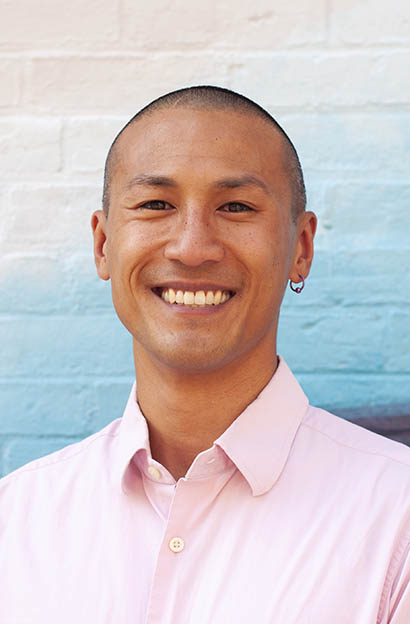
ERIC NGUYEN ’00
Expanding opportunities for first-generation college students
In what ways do existing policies and practices favor certain students while disadvantaging others? How can more equitable systems be created for all groups? Eric Nguyen ’00 wrestles with these questions with colleagues across Northeastern University, where he is the senior assistant director of opportunity scholarship and outreach programs. “I want to push us beyond simply thinking about granting access so we can more fully include all of our students,” he says.
Nguyen is passionate about creating equitable programs, communities in which all students feel they belong, and opportunities for individuals to take ownership of their experiences. He supports around 180 scholarship recipients, most of whom identify as first-generation, low-income, and/or students of color, empowering them to make the most of Northeastern’s programs and resources. Raised in Lowell, Mass., by parents from Vietnam, Nguyen received financial aid to attend CA, and his experiences sparked his desire to pursue a career in education. “Feeling fully seen and cared for was a hallmark of my experience,” he says. “It has really shaped my work with students, which is highly relational.”
After graduating from Amherst College, Nguyen taught math and science at several independent schools. He also helped launch and later lead Achieve, an academic enrichment program for students from under-resourced Boston communities. After overseeing a shift in its mission to support students all the way through high school, Nguyen recognized a gap in support for students once they set foot on college campuses.
Now at Northeastern, his work is having a multiplier effect. For example, one student who approached him last spring for help understanding a lease agreement became increasingly involved at the university and spent this summer developing a pre-orientation program for first-generation Latinx students. “When you improve a process for a specific student population, I firmly believe that it improves the experience for all students,” Nguyen says.
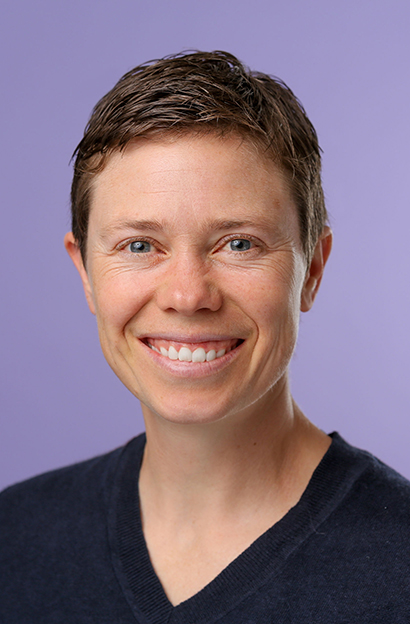
IZZY LOWELL ’98
Runs a telemedicine practice for transgender patients in the Southeast
Around 1.4 million adults in the United States identify as transgender, according to a 2016 study by the Williams Institute. “That’s more people than have Type 1 diabetes, a condition we learn about extensively in medical school,” says physician Izzy Lowell ’98, who specializes in transgender health care. “Hormone therapy is so much easier than diabetes, but many people think this isn’t a valid medical issue.”
That denial has health consequences. “Over one-third of trans patients have been harassed or denied care by a doctor,” she says. “Many don’t want to go to a doctor or even the ER. This stigma has layers of repercussions.”
In medical school, Lowell learned nothing about transgender health, so during her residency in Lawrence, Mass., she developed her own elective in collaboration with Philadelphia’s Mazzoni Center. Upon moving to Atlanta with her wife in 2013, Lowell joined the faculty of Emory University and opened a clinic, QMed, to offer care for transgender and nonbinary children, teens, and adults.
Through videoconference visits, Lowell treats patients throughout the Southeast, where few doctors are knowledgeable about transgender health. This kind of telemedicine doesn’t require physical exams. “A diagnosis of gender dysphoria is about how that person feels in their body,” Lowell says.
The clinic has grown quickly and now serves more than 1,000 patients. “We’re doing the opposite of what should be done, though,” Lowell says. “I hope that one day we won’t need special clinics, that all primary care doctors will manage transgender health.”
She’s optimistic. In July, Lowell spoke at the American Academy of Family Physicians conference. “It was amazing to be on that stage,” she says. “It really indicates support. And for medical students now, trans care is a hot topic. It gives me comfort knowing that the next generation of doctors is being trained.”

TONY PATT ’83
Climate change professor making policy recommendations in Europe
“For a long time, I saw climate change from an economic perspective,” says Tony Patt ’83, a professor of climate policy at ETH Zürich in Switzerland. “We’ve been locked into that paradigm of marginal improvement since the Industrial Revolution, but other approaches are more useful for thinking about discontinuities in society, times of radical change.” This, he says, is one of those times. After studying architecture at Yale in the 1980s, narrowly missing a modern pentathlon Olympic berth, and earning his law degree at Duke, Patt practiced environmental law in Vermont. On the ski slopes in the early 1990s, he saw signs that local climate action would be insufficient. He changed course, completing a doctorate at Harvard in environmental public policy.
Now Patt makes policy recommendations to European governments, identifying successful approaches to eliminating societal greenhouse gas emissions within a short timeframe. His research shows that some popular approaches, such as carbon taxes, are ineffective.
What is making a difference? “We need a complete restructuring of technologies for getting and using energy,” Patt says. “Solar and wind are now the cheapest energy sources, and countries do want them. They don’t need to be forced into legally binding commitments. They just need help.
“As the exponential growth of renewable energy continues — and it will, if we keep the policies we have in place — fossil fuel consumption will shrink.” His models show this starting to happen soon.
“For 20 years we’ve been laying the foundation for dealing with this crisis,” he says. “It’s essential that we build on it with strong policies. That’s possible now in Europe, in Canada, and in several states in the U.S. And it’s becoming possible in more and more developing countries, which are seeing the drawbacks of reliance on fossil fuels.”
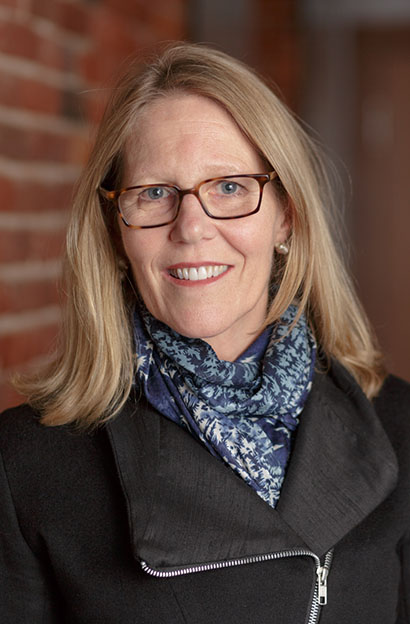
AMY LONGSWORTH ’76
Director of the Boston Green Ribbon Commission
The city of Boston sits at sea level; entire neighborhoods are built upon landfill. And the sea is rising. In economic terms, the World Bank has estimated that Boston is the fourth most vulnerable city in the United States, and the eighth in the world. A nor’easter hitting at high tide is a scenario Amy Longsworth ’76, who has directed the Boston Green Ribbon Commission (GRC) since 2015, keeps in mind.
The GRC is a volunteer group of business, institutional, and civic leaders that formed in 2010 to develop and share strategies for addressing climate change in coordination with the City of Boston. The Carbon Free Boston and Climate Ready Boston reports, which address carbon mitigation and climate resilience, respectively, and upon which much of Boston’s Climate Action Plan is based, are two examples of GRC work. The GRC also manages four sector working groups — higher education, health care, commercial real estate, and cultural organizations.
Boston’s cultural institutions, preparing for a year of climate-related programming kicking off in 2020, have a “unique ability to influence individuals,” Longsworth says, “and the commercial sector holds the highest leverage for reducing the most carbon.”
Longsworth has made a career of bringing business into the environmental fold. A Massachusetts native who returned after 30 years in Washington, where she worked first with corporations at the Nature Conservancy and then as a corporate sustainability consultant, Longsworth calls climate change “the existential question of our time.”
Boston, Longsworth says, is a “big enough but small enough city” to take meaningful action, and there’s now “considerable pressure to be aware of climate risks and actions.”
“We have the technology,” Longsworth says. “It’s a matter of pivoting from the science to the will to get it done. We can improve the situation by 2050. The world’s a mess, and that’s a reality. But the opportunity is a reality too.”

